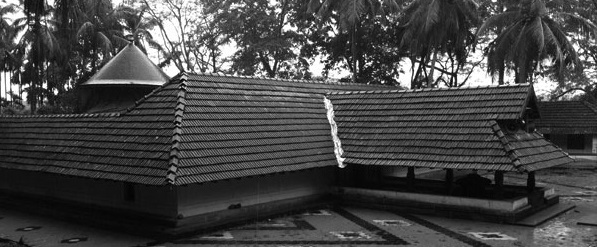DEITIES ( UPADEVAS )
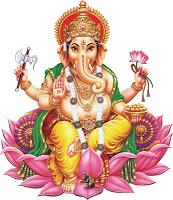 In almost all Kerala temples, Ganapathy will find a place among upadevas of the main pradishtas and is one of the best-known and most widely worshipped deities in the Hindu pantheon.
Ganapathy is widely revered as the Remover of Obstacles and more generally as the Lord of Beginnings and the Lord of Obstacles, patron of arts and sciences, and the deva of intellect and wisdom.
Here the Ganapathy shrine is situated within the Nalambalam itself, at the south-eastern corner.
In almost all Kerala temples, Ganapathy will find a place among upadevas of the main pradishtas and is one of the best-known and most widely worshipped deities in the Hindu pantheon.
Ganapathy is widely revered as the Remover of Obstacles and more generally as the Lord of Beginnings and the Lord of Obstacles, patron of arts and sciences, and the deva of intellect and wisdom.
Here the Ganapathy shrine is situated within the Nalambalam itself, at the south-eastern corner.
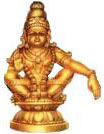 At the northern side of the temple, outside the Nalambalam and just inside the pradikshinavazhy is the shrine of Sastha.There is a huge granite stone in front of the shrine, placed in an inclined position, for breaking coconuts, considered very dear to Sastha. During the mandala season, lot of devotees take darshan at this shrine. In front of the shrine arrangements are made for "malayidal" and "kettunira" for Sabarimala pilgrimage during Mandala season.
At the northern side of the temple, outside the Nalambalam and just inside the pradikshinavazhy is the shrine of Sastha.There is a huge granite stone in front of the shrine, placed in an inclined position, for breaking coconuts, considered very dear to Sastha. During the mandala season, lot of devotees take darshan at this shrine. In front of the shrine arrangements are made for "malayidal" and "kettunira" for Sabarimala pilgrimage during Mandala season.
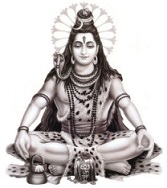 Shiva is 'shakti' or power, Shiva is the destroyer, the most powerful god of the Hindu pantheon and one of the godheads in the Hindu Trinity. Known by many names - Mahadeva, Mahayogi, Pashupati, Nataraja, Bhairava, Vishwanath, Bhava, Bhole Nath - Lord Shiva is perhaps the most complex of Hindu deities. Hindus recognize this by putting his shrine in the temple separate from those of other deities.
In a Shaivite temple,the 'linga' is placed in the center underneath the spire, where it symbolizes the naval of the earth.
Lord Shiva is situated inside the Nalambalam , at the Northern side.
Shiva is 'shakti' or power, Shiva is the destroyer, the most powerful god of the Hindu pantheon and one of the godheads in the Hindu Trinity. Known by many names - Mahadeva, Mahayogi, Pashupati, Nataraja, Bhairava, Vishwanath, Bhava, Bhole Nath - Lord Shiva is perhaps the most complex of Hindu deities. Hindus recognize this by putting his shrine in the temple separate from those of other deities.
In a Shaivite temple,the 'linga' is placed in the center underneath the spire, where it symbolizes the naval of the earth.
Lord Shiva is situated inside the Nalambalam , at the Northern side.
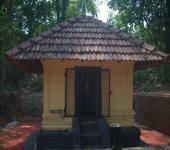 According to the Hindu mythology, lord Vishnu was impressed by the might of Bali, grandson of the great devotee Prahalada (a great devotee of Vishnu). Lord Vishnu was so pleased that he promised him divine protection and immortality until Bali was crowned Indra. To keep his promise, lord Vishnu left his abode in the heaven and started guarding Bali. Alarmed at this, Goddess Lakshmi (the consort of Lord Vishnu) decided to bring lord Vishnu back to his divine abode.
Goddess Lakshmi disguised herself as a Brahmin woman and went to Bali to seek protection till her husband returns. Bali, kind by nature, welcomed her (Lakshmi) into his palace. Lakshmi was in the lookout for the right opportunity and came on the occasion of Shravana Purnima; Lakshmi tied a colored cotton thread (Rakhi) on Bali's wrist. Bali was greatly touched by this gesture of the Brahmin women (Lakshmi) and asked her for a gift. Lakshmi grabbed this opportunity and revealed her real identity and asked Bali to let go her husband (lord Vishnu). As Bali had given his words, he had to relent but he extracted a promise from the couple to visit his palace every year on this day for a meal with him.
Taking cue from this tradition sisters visit their brothers on the day of Raksha Bandhan (Shravana Purnima) and have meal with them. On this auspicious day, they tie a thread (Rakhi) on the wrist of their brothers and wish for their long life and prosperity.
According to the Hindu mythology, lord Vishnu was impressed by the might of Bali, grandson of the great devotee Prahalada (a great devotee of Vishnu). Lord Vishnu was so pleased that he promised him divine protection and immortality until Bali was crowned Indra. To keep his promise, lord Vishnu left his abode in the heaven and started guarding Bali. Alarmed at this, Goddess Lakshmi (the consort of Lord Vishnu) decided to bring lord Vishnu back to his divine abode.
Goddess Lakshmi disguised herself as a Brahmin woman and went to Bali to seek protection till her husband returns. Bali, kind by nature, welcomed her (Lakshmi) into his palace. Lakshmi was in the lookout for the right opportunity and came on the occasion of Shravana Purnima; Lakshmi tied a colored cotton thread (Rakhi) on Bali's wrist. Bali was greatly touched by this gesture of the Brahmin women (Lakshmi) and asked her for a gift. Lakshmi grabbed this opportunity and revealed her real identity and asked Bali to let go her husband (lord Vishnu). As Bali had given his words, he had to relent but he extracted a promise from the couple to visit his palace every year on this day for a meal with him.
Taking cue from this tradition sisters visit their brothers on the day of Raksha Bandhan (Shravana Purnima) and have meal with them. On this auspicious day, they tie a thread (Rakhi) on the wrist of their brothers and wish for their long life and prosperity.
Here the Vishnurakshas shrine is situated outside the Nalambalam, at the North-western corner.
 The concept of Sankaranarayana is the outcome of reconciliation of the Vaishnavite and Saivite cults.The vigraha of Lord Sankaranrayanaa is in linga shape.Those who worship Lord Sankaranarayana are the blessed as stated in Skandopanishad.
Sivaaya Vishnurupaaya Sivarupaaya Vishnave Sivasyahridayam Vishnuth Vishnosthuhridayam Sipathi Yathha Sivamayo Vishnuthi evam Vishnumayathi Sivath Yathhantaram na paSyami tathhame swasthirayusthi
Lord Sankaranarayanan shrine is situated inside the Nalambalam , at the North-eastern side.
The concept of Sankaranarayana is the outcome of reconciliation of the Vaishnavite and Saivite cults.The vigraha of Lord Sankaranrayanaa is in linga shape.Those who worship Lord Sankaranarayana are the blessed as stated in Skandopanishad.
Sivaaya Vishnurupaaya Sivarupaaya Vishnave Sivasyahridayam Vishnuth Vishnosthuhridayam Sipathi Yathha Sivamayo Vishnuthi evam Vishnumayathi Sivath Yathhantaram na paSyami tathhame swasthirayusthi
Lord Sankaranarayanan shrine is situated inside the Nalambalam , at the North-eastern side.
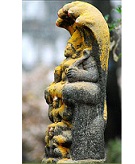 According to tradition, Kerala was created from the Arabian Sea by Parasurama and donated to Brahmins as a compensation for the sin of having slaughtered numerous Kshatriya dynasties. The land was covered in forest and home to snakes, and found to be inhospitable by Brahmins, who refused to stay there. Parasurama requested Lord Shiva to provide a solution, who advised that the Brahmins should start worshipping Ananta, the King of Snakes, and the bed on which Lord Vishnu reclines.
The Sarpakavu is situated outside the Nalambalam , at the North-Western corner.
According to tradition, Kerala was created from the Arabian Sea by Parasurama and donated to Brahmins as a compensation for the sin of having slaughtered numerous Kshatriya dynasties. The land was covered in forest and home to snakes, and found to be inhospitable by Brahmins, who refused to stay there. Parasurama requested Lord Shiva to provide a solution, who advised that the Brahmins should start worshipping Ananta, the King of Snakes, and the bed on which Lord Vishnu reclines.
The Sarpakavu is situated outside the Nalambalam , at the North-Western corner.
GALLERY

